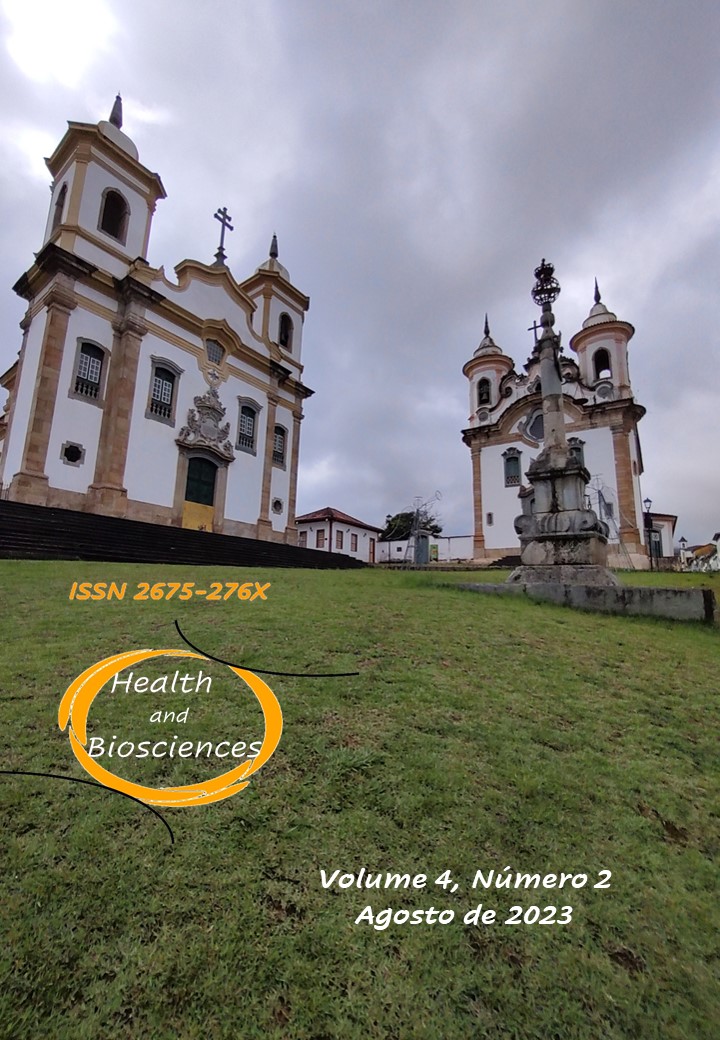Nutritional status of children under 10 years old accompanied in a Basic Health Unit in Mariana, Minas Gerais
Nutritional status of children under 10 years old
DOI:
https://doi.org/10.47456/hb.v4i2.40852Keywords:
nutritional status, public health, food and nutritional surveillanceAbstract
The Vigilância Alimentar e Nutricional is a fundamental component of health surveillance, enabling the continuous description and prediction of trends in food and nutrition of the population and their determining factors, with the data collected being consolidated in SISVAN Web. The information generated provides a diagnosis and follow-up of the population's food and nutrition situation, which is an essential component for the development of public policies. The present study aims to describe the nutritional status of children under 10 years of age, monitored by SISVAN in a UBS in Mariana-MG. Data were obtained from the information system of the Ministry of Health, SISVAN Web, for the years 2015-2019, being collected in 2021. With regard to follow-up, 2016 had the highest number of children registered (284) and in 2015 the smallest, with 151 children. Regarding children diagnosed with overweight, the highest prevalence was recorded in 2017 (19%), with a decrease in prevalence in subsequent years (2018: 12.7%; 2019: 11.9%). With regard to thinness, the numbers are smaller, but existing, reaching a lower prevalence in 2017 (2.9%), with a progressive increase in subsequent years (2018:5.4%; 2019:8.5%). Excess weight among the monitored children showed a higher prevalence, but thinness coexisted. SISVAN, although it still has a low population coverage, proves to be an important instrument for the health team, contributing to greater knowledge of the population assisted by the SUS, in addition to assisting in the elaboration and implementation of policies and actions aimed at the nutritional needs of each population.
Downloads
References
BRASIL. MINISTÉRIO DA SAÚDE. Guia para a organização da Vigilância Alimentar e Nutricional na Atenção Primária à Saúde [recurso eletrônico] / Ministério da Saúde. Universidade Federal de Sergipe. – Brasília: Ministério da Saúde, 2022a.
BRASIL. MINISTÉRIO DA SAÚDE. e-Gestor Atenção Básica: Informação e Gestão da Atenção Básica, 2022b. Histórico de Cobertura - APS. Disponível em: <https://egestorab.saude.gov.br/paginas/acessoPublico/relatorios/relCoberturaAPSCadastro.xhtml> Acesso em 05 de setembro de 2022.
BRASIL. MINISTÉRIO DA SAÚDE. Secretaria de Atenção à Saúde. Departamento de Atenção Básica. Marco de referência da vigilância alimentar e nutricional na atenção básica / Ministério da Saúde, Secretaria de Atenção à Saúde, Departamento de Atenção Básica. – Brasília, 2015.
BRASIL. MINISTÉRIO DA SAÚDE. Secretaria de Atenção à Saúde. Departamento de Atenção Básica. Política Nacional de Alimentação e Nutrição / Ministério da Saúde, Secretaria de Atenção à Saúde. Departamento de Atenção Básica. Básica. – 1. ed., 1. reimpr. – Brasília: Ministério da Saúde, 2013.
BRASIL. MINISTÉRIO DA SAÚDE. Secretaria de Atenção à Saúde. Departamento de Atenção Básica. Orientações para a coleta e análise de dados antropométricos em serviços de saúde Norma Técnica do Sistema de Vigilância Alimentar e Nutricional - SISVAN / Ministério da Saúde, Secretaria de Atenção à Saúde, Departamento de Atenção Básica. – Brasília: Ministério da Saúde, 2011.
BRASIL. IBGE - Instituto Brasileiro de Geografia e Estatística. Cidades IBGE. 2010. Disponível em: <https://cidades.ibge.gov.br/brasil/mg/mariana/pesquisa/23/47427?detalhes=true> Acesso em 20 de setembro de 2022.
CAMARGO CC, BOZELLI I, TOME FK, CLAUDIO ACJ, MENOSSI BRS. A permanência da desnutrição infantil em escolares do Norte Pioneiro do Paraná após transição nutricional: um Estudo Longitudinal de 5 anos. Braz. Journal of Devel 7(7): 70944-70955, 2021.
CUNHA, C. ‘A gente não quer só comida’: integralidade na atuação interprofissional no cuidado da obesidade infantil. Saúde debate 46(5): 284-296, 2022.
HOFFMANN R. Insegurança Alimentar no Brasil após crise, sua evolução de 2004 a 2017-2018 e comparação com a variação da pobreza. Segur. Aliment. Nutr 28:1-17, 2021.
MOREIRA NF, SOARES CA, JUNQUEIRA TS, MARTINS RCB. Tendências do estado nutricional de crianças no período de 2008 a 2015: dados do Sistema de Vigilância Alimentar e Nutricional (Sisvan). Cad. Saude Colet 28(3): 447-454, 2020.
NASCIMENTO FA, SILVA AS, JAIME PC. Cobertura da avaliação do estado nutricional no Sistema de Vigilância Alimentar e Nutricional brasileiro: 2008 a 2013. Cad. Saude Pub 33(12): e00161516, 2017.
SILVA DNSL, BOMFIM RO, VIEIRA AD. Excesso de peso em crianças brasileiras de 1 a 10 anos de idade. Cienc. Biológicas Saude Unit 5(3): 139-148, 2019.
SILVA RPC, VERGARA CMAC, SAMPAIO HAC, FILHO JEV, STROZBERG F, NETO JFRF, MAFRA MLP, FILHO CG, CARIOCA AAF. Sistema de Vigilância Alimentar e Nutricional: tendência temporal da cobertura e estado nutricional de adultos registrados, 2008-2019. Epidem. Serviços Saud 31(1): e2021605, 2022.
UNIVERSIDADE FEDERAL DO RIO DE JANEIRO. Estado Nutricional Antropométrico da Criança e da Mãe: Prevalência de indicadores antropométrico de crianças brasileiras menores de 5 anos de idade e suas mães biológicas: ENANI 2019. Documento eletrônico. Rio de Janeiro: UFRJ, 2022. (96 p.). Coordenador geral, Gilberto Kac. Disponível em: <https://enani.nutricao.ufrj.br/index.php/relatorios/>. Acesso em 20 setembro de 2022.
WANG Y, LIM H. The global childhood obesity epidemic and the association between socio-economic status and childhood obesity. Int. rev. psychiatry 24(3): 176–188, 1 jun. 2012.
WHO. Child Growht Standards, 2006. Disponível em: <http://www.who.int/childgrowth/en/>. Acesso em 20 setembro de 2022.
WHO. Growht reference data for 5-19 Years, 2007. Disponível em: <http://www.who.int/growthref/en/>. Acesso em 20 setembro de 2022.

